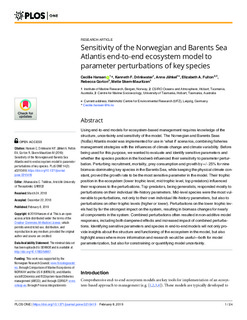| dc.description.abstract | Using end-to-end models for ecosystem-based management requires knowledge of the structure, uncertainty and sensitivity of the model. The Norwegian and Barents Seas (NoBa) Atlantis model was implemented for use in ‘what if’ scenarios, combining fisheries management strategies with the influences of climate change and climate variability. Before being used for this purpose, we wanted to evaluate and identify sensitive parameters and whether the species position in the foodweb influenced their sensitivity to parameter perturbation. Perturbing recruitment, mortality, prey consumption and growth by +/- 25% for nine biomass-dominating key species in the Barents Sea, while keeping the physical climate constant, proved the growth rate to be the most sensitive parameter in the model. Their trophic position in the ecosystem (lower trophic level, mid trophic level, top predators) influenced their responses to the perturbations. Top-predators, being generalists, responded mostly to perturbations on their individual life-history parameters. Mid-level species were the most vulnerable to perturbations, not only to their own individual life-history parameters, but also to perturbations on other trophic levels (higher or lower). Perturbations on the lower trophic levels had by far the strongest impact on the system, resulting in biomass changes for nearly all components in the system. Combined perturbations often resulted in non-additive model responses, including both dampened effects and increased impact of combined perturbations. Identifying sensitive parameters and species in end-to-end models will not only provide insights about the structure and functioning of the ecosystem in the model, but also highlight areas where more information and research would be useful—both for model parameterization, but also for constraining or quantifying model uncertainty. | nb_NO |
